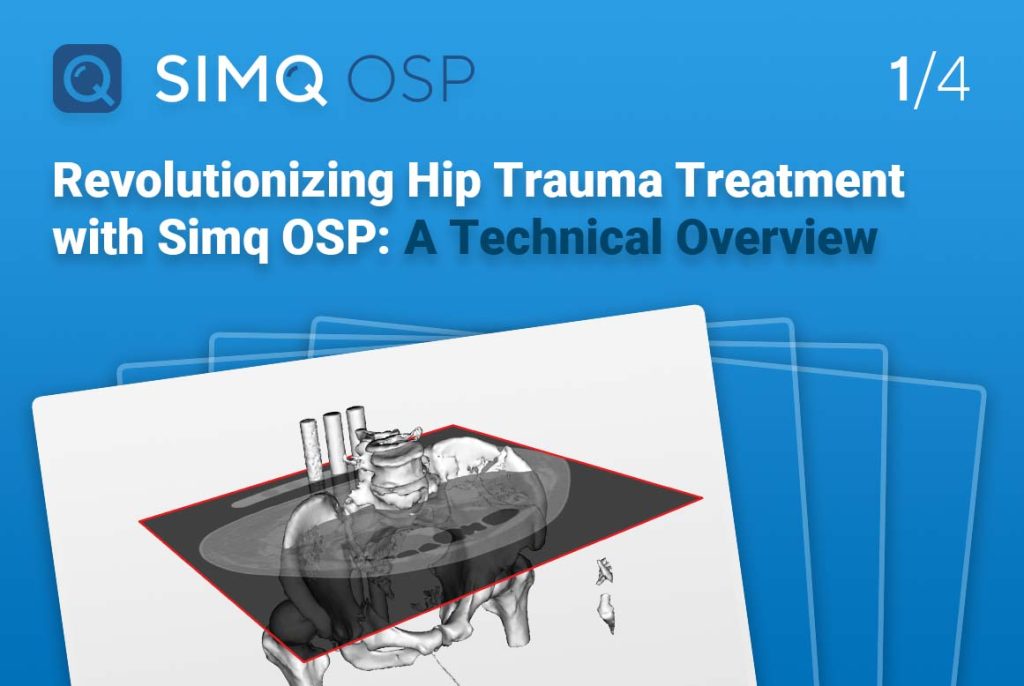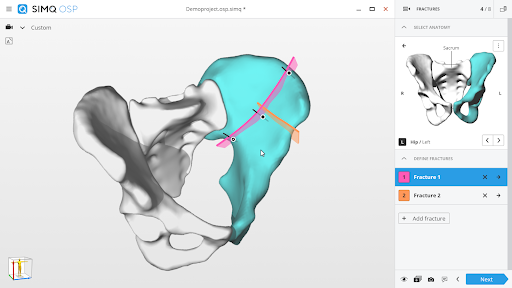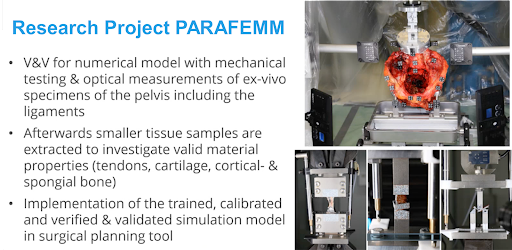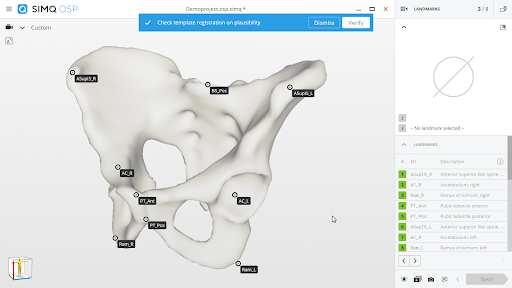Hip trauma treatment has entered a new era with the advent of Simq OSP. This cutting-edge numerical tool integrates advanced simulations, parametric modeling, and statistical representation into surgical planning. In this blog, we embark on a technical journey to unravel the intricacies of Simq OSP and understand how it is reshaping the landscape of hip trauma treatment for medical and engineering enthusiasts alike.

The Complexity of Hip Trauma and Surgical Planning
Hip trauma encompasses a wide spectrum of injuries, ranging from fractures and dislocations to complex cases involving damage to tendons, soft tissues, and nerves. Treating these injuries demands meticulous surgical planning to ensure successful outcomes. Historically, this planning process was arduous and time-consuming for medical professionals.
Traditional surgical planning methods often involved manual segmentation to create patient-specific geometries, which was a time-intensive endeavor. The complexity of the hip joint, with its multiple components such as bones, cartilage, ligaments, and tendons, further compounded the challenge. Additionally, factors like fracture type, surgical approach, patient age, and overall health needed consideration to determine the most suitable intervention.
These challenges, when addressed with conventional methods, led to time-consuming processes vulnerable to human errors. Consequently, the medical field began exploring advanced technologies to enhance personalized surgical planning, reduce operating room (OR) time, and ultimately improve patient outcomes.

Introducing Simq OSP: Personalization of Hip Trauma Treatment
In recent years, the landscape of personalized medical treatments has evolved significantly, thanks to innovations like Simq OSP. Simq OSP represents a groundbreaking solution designed to support personalized hip trauma treatment, bridging the gap between engineering simulations and medical expertise.
Here are the key features and capabilities that make Simq OSP a game-changer in hip trauma treatment:
Virtual Surgical Planning with Standard Plates: Simq OSP enables surgeons to virtually plan the entire surgical procedure using 3D models, considering the hardware and plates available in the hospital’s stock. This ensures all necessary materials are readily available, reducing the risk of surgical delays.
Extensive Implant Library: The software offers a vast library of implants, including screws, plates, and other hardware. Surgeons can select the most suitable implant based on the patient’s injury and anatomy, all within the virtual environment.
Personalized Surgical Planning: Surgeons can choose the plate type and precisely determine its positioning on the 3D model. This level of customization empowers surgeons to adapt the surgical plan to each injury’s unique aspects.
Virtual Preselection and Prebending of Implants: Besides planning, surgeons can virtually preselect and prebend the plates used in surgery. This streamlines the actual surgical process, improving efficiency and potentially reducing OR time.
Biomechanical Analysis: Simq OSP allows for biomechanical analyses within the virtual environment. Surgeons can compare different surgical techniques, approaches, and implant options to determine which offers the most favorable biomechanical outcomes. This adds a layer of pre-operative planning that significantly impacts surgical success.
With Simq OSP, surgeons can manipulate virtual models and simulate various surgical approaches to assess potential outcomes before setting foot in the operating room. This integrated approach enhances the likelihood of success while minimizing the risks associated with complex surgeries.
The Research Project: Developing a Parametric Hip Simulation Model
At the heart of Simq OSP lies a collaborative research project focused on developing a parametric hip simulation model. This project underscores the importance of collaboration between engineering and medical sciences experts to create a surgical planning tool that is comprehensive, accurate, and applicable to real-life scenarios.

Collaboration with Research Partners and Project Objectives
The research project emphasizes collaboration among stakeholders from diverse fields to address the challenges associated with hip simulation modeling. The project aims to enhance surgical planning accuracy and improve patient-specific outcomes by combining expertise and resources from multiple disciplines. Collaboration between engineers and medical professionals becomes pivotal in creating a tool like Simq OSP.
Building a Population-Based Parametric Model for Hip Trauma
Data from a diverse patient population is collected and analyzed to create an effective simulation model. This data is used to develop a comprehensive and representative population-based geometry model from which the parametric simulation model is derived. By incorporating data from multiple sources with different anatomical variations, the model can better reflect the diverse patient population encountered in clinical practice. Accurate representation of hip trauma cases in the model is critical for surgical planning, helping healthcare professionals make informed decisions based on realistic scenarios.
Integration of Fitting and Morphing Algorithms for Model Generation
One of the research project’s goals is to customize the simulation model to match individual patient anatomies accurately. Fitting algorithms analyze patient-specific data, medical image data, and landmarks to align the model with the patient’s unique pelvis anatomy.
Morphing algorithms further refine the model by adapting it to specific patient characteristics and requirements. These algorithms allow for a well-defined computational model within seconds, as every entity, position of ligaments, and muscle attachment points of the parametric model are already defined and known.

Training, Calibration, and Validation through Ex Vivo Mechanical Testing and Optical Measurements
The parametric computational pelvic model undergoes rigorous training, calibration, and validation to ensure credibility. The model is trained on ex-vivo specimens scanned by imaging modalities such as CT to collect critical anatomical and biomechanical data.
During the calibration phase, real-world data sets are assimilated into the model to fine-tune its parameters. In the validation phase, optical range-of-motion measurements using advanced tracking systems evaluate the model’s ability to predict biomechanical behavior accurately. Subsequent mechanical tests on disassembled ex-vivo specimens provide realistic material properties, matching the actual biomechanical properties. This meticulous process ensures that the parametric computational pelvic model is a robust and reliable resource for surgical planning and biomechanical analysis.
Disassembling the Hips for Tissue-Specific Tests and Accurate Strain Extraction
Simq OSP takes a comprehensive approach by simulating the response of various tissues during movement. Disassembling the hips allows for examining individual tissue components and their interactions, enabling a detailed analysis of the software’s accuracy and effectiveness.
Hip Trauma Treatment: High Scientific Standards and Adherence to Rigorous Validation Protocols
Maintaining high scientific standards throughout the development and validation process is crucial for ensuring the reliability and credibility of Simq OSP. The software undergoes rigorous validation protocols, involving thorough testing, analysis, and comparison with established standards and reference data. These protocols are strictly applied to validate the software’s accuracy and reliability, reassuring users and stakeholders in its utilization for surgical planning and decision-making processes.
Simq OSP: A Market-Ready Patient-Specific Medical Simulation Tool
The evolution of Simq OSP from a research project to a market-ready product is a crucial achievement for the company. Simq OSP is a commercial product with an array of features and capabilities that cater to the needs of its users.
Simq OSP offers users a range of advanced features, including real-time data monitoring, powerful analytics, and customizable dashboards. The product’s capabilities allow users to gather insights into their data and make informed decisions based on the information they receive.
Moreover, Simq OSP’s user-friendly interface and intuitive design make it accessible to users of all levels of expertise. The product is easy to navigate and provides users with a seamless experience.
In summary, Simq OSP is a robust commercial product offering its users a range of features and capabilities. The product’s easy-to-use interface and powerful analytics make it an ideal solution for businesses seeking insights into their data and making informed decisions.





